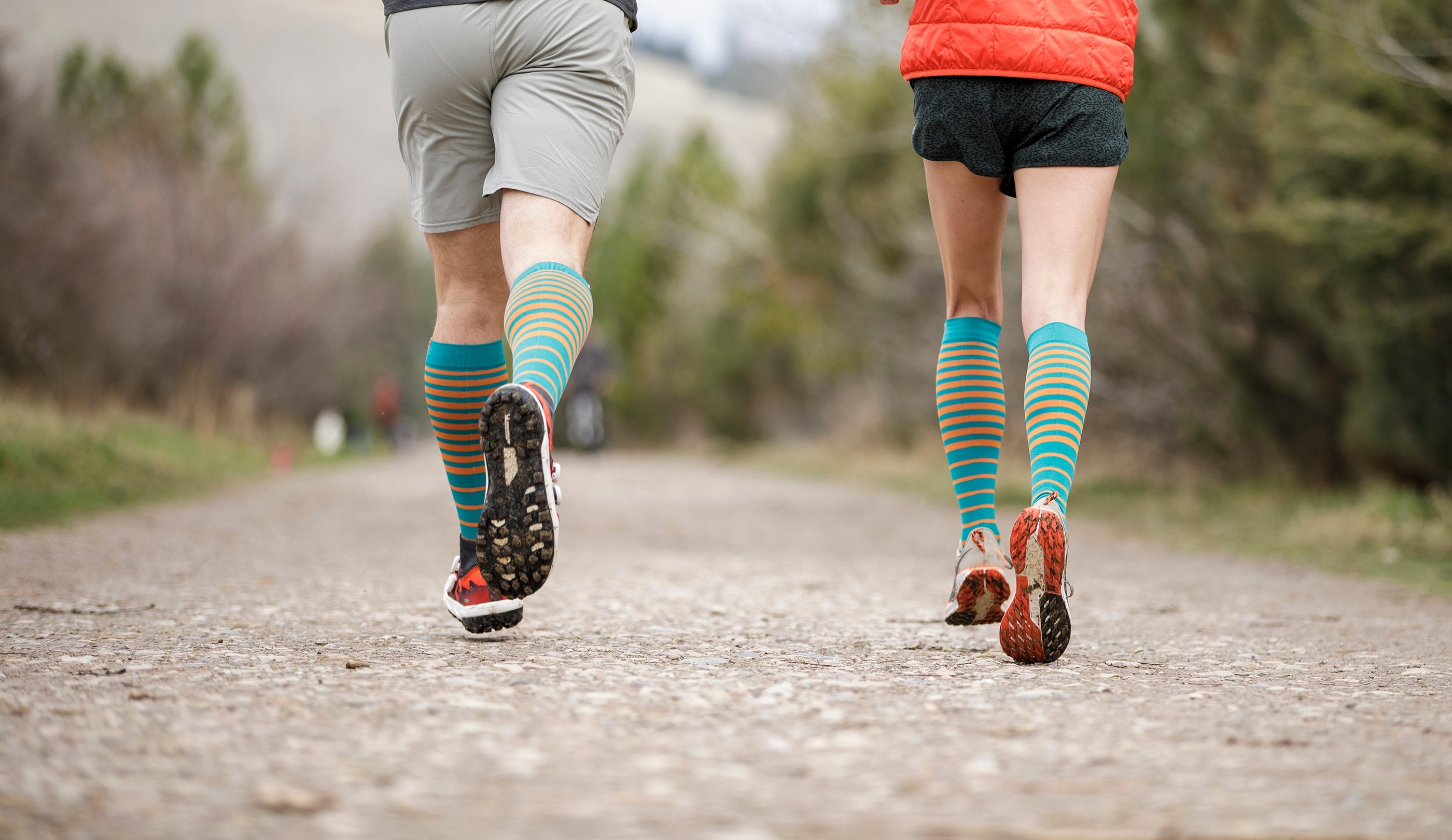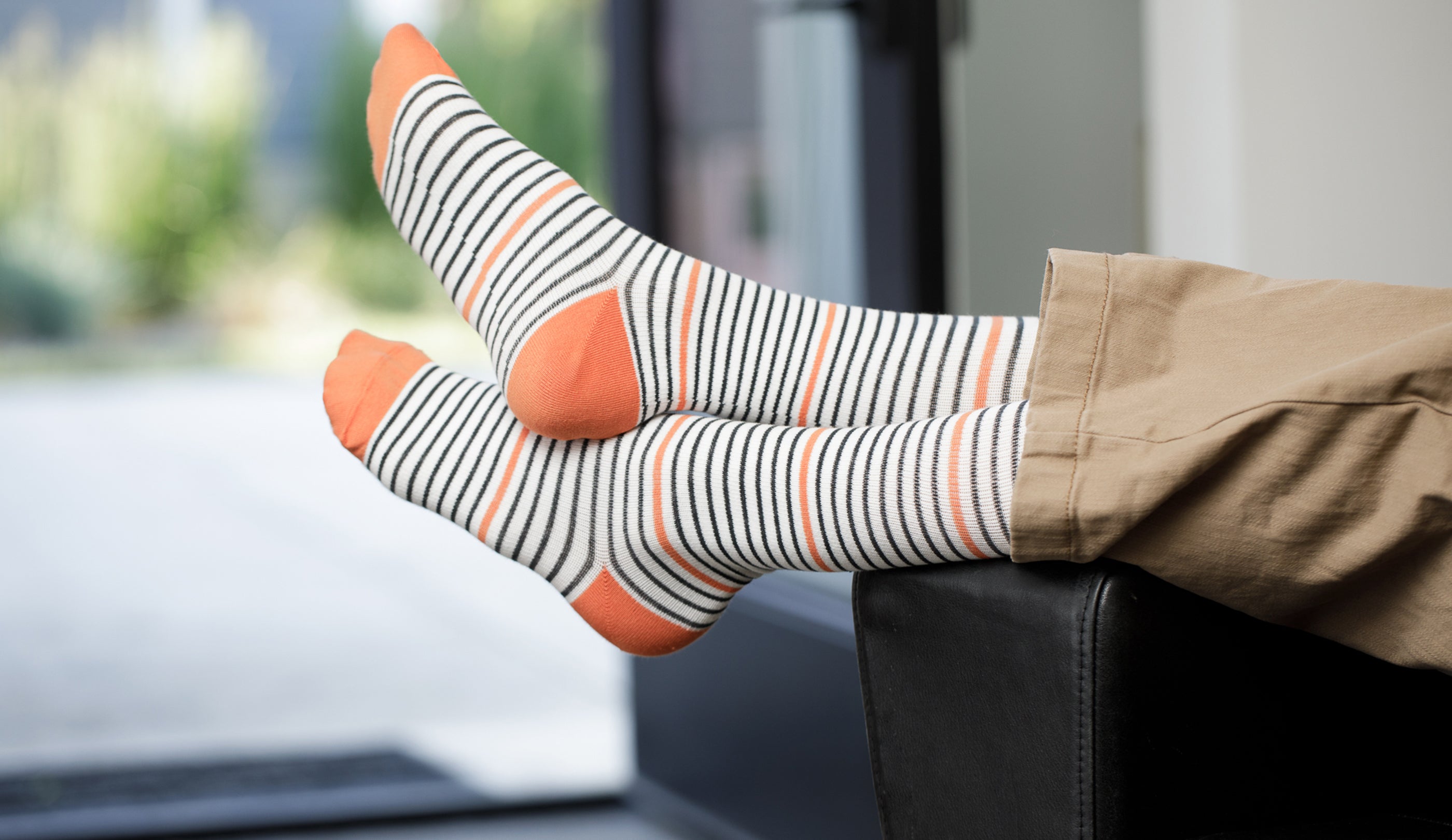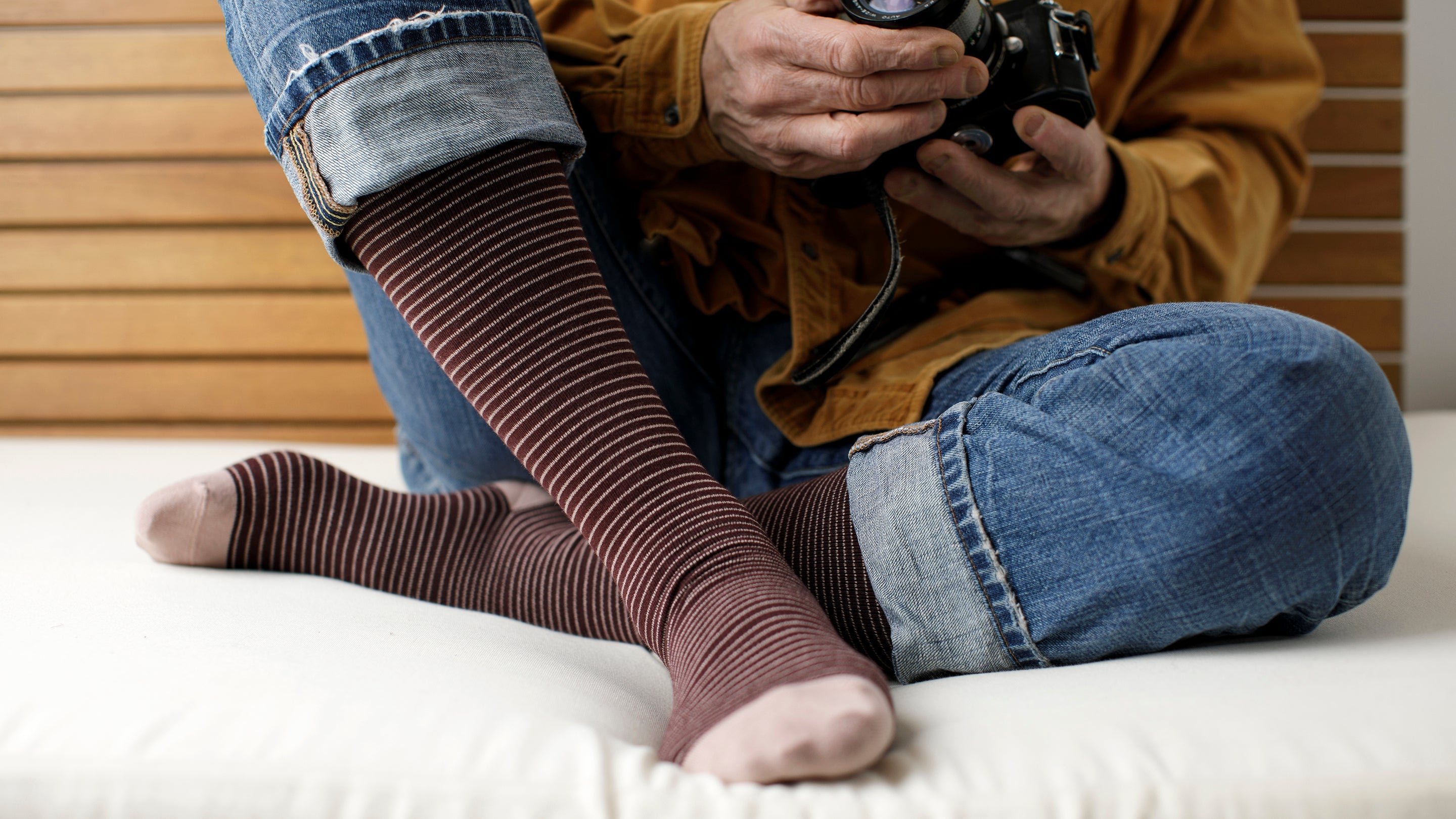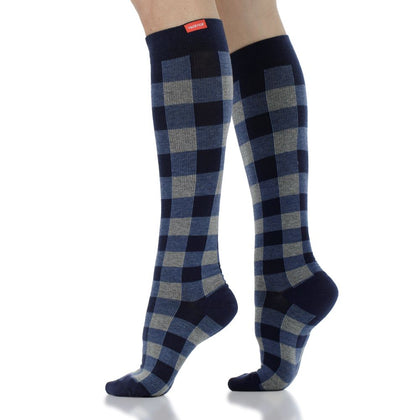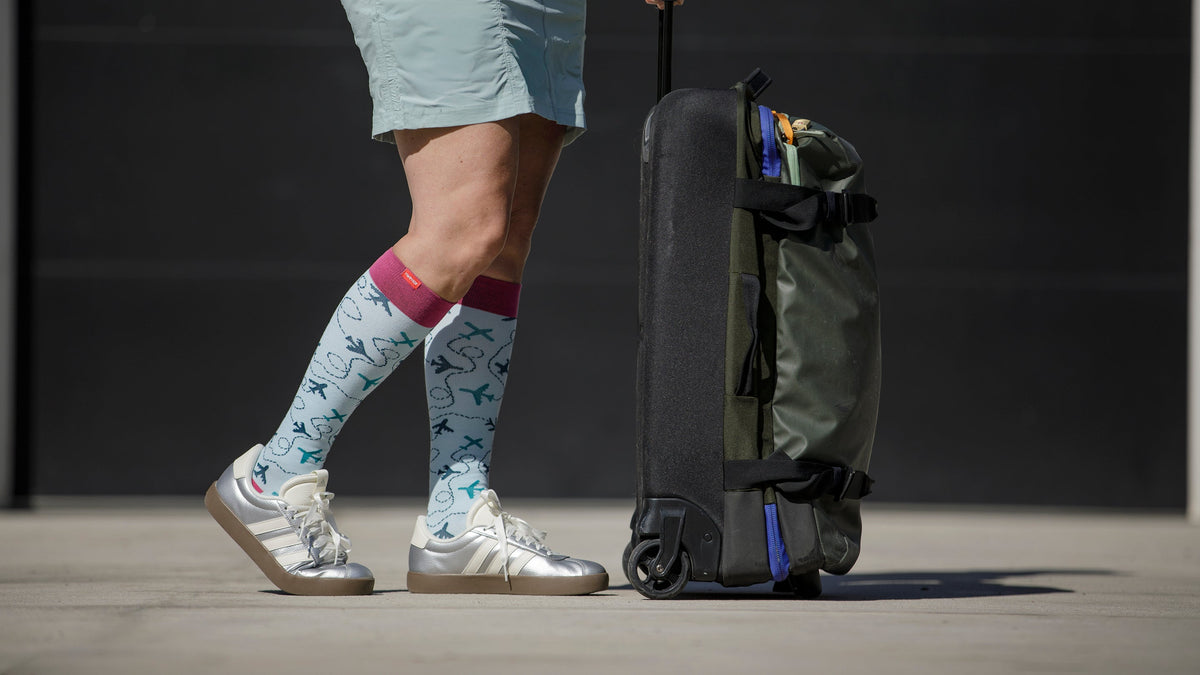

Long flights can be exhausting, but they can also be dangerous if you’re at risk of developing DVT (deep vein thrombosis) and have not prepared. The Center for Disease Control warns that travelers who take journeys of 4 hours or longer (by plane, but also in cars, buses, or trains) have an increased risk of blood clots and DVT. While many blood clots are small and resolve on their own, developing DVT due to traveling can lead to a pulmonary embolism, which can be fatal. This is not even mentioning all the other discomforts associated with sitting for long periods of time: feet and lower legs swelling, aches and pains, numbness, pins and needles, just to name a few.
However, the good news is that there are many ways to ensure you fly safely, minimizing your risk of DVT. In this article, we discuss 10 easy and actionable tips for better circulation and reduced risks on your travels.
How to Avoid DVT On Long Flights
The key to avoiding DVT when flying is to keep the legs moving and stimulating lower limb circulation as much as possible. This includes in-cabin movement, stretches, wearing comfortable clothing, and using effective tools like compression socks.
1. Wear Compression Socks or Leggings
Compression socks or leggings prevent deep vein thrombosis on flights. Thanks to the therapeutic pressure they apply to the lower legs, compression socks stimulate circulation, particularly the return of blood toward the heart. This prevents blood from pooling at the periphery, i.e. the ankles and lower legs.
A systematic review of 12 different studies identified how effective compression socks were in preventing DVT. The evidence suggests that passengers wearing these garments reduced their risk of symptomless DVT, while some also reported reduced leg edema (swelling).
That scientific article found that compression stockings reduce the risk of DVT when flying by up to 90%!
Moreover, compression socks and leggings are a stylish way to fight that unpleasant economy class syndrome… although people traveling in business class deal with the same issues. Simply having more leg room does not reduce the impact of lack of movement unless you are extremely disciplined about stretching and walking around. Wearing colorful, good-looking knee-high compression socks will have you feeling stylish in the airport, while improving your circulation and massaging your muscles during the flight. And you can hit the town for social events as soon as you land!
Additionally, compression leggings are a great solution for improving circulation while flying. They look good, feel comfortable, and can be a great option for an airplane outfit that provides you with extra benefits. In fact, wearing compression socks improves comfort when flying for 3 or more hours (according to this study).

2. Stay Hydrated Before and During the Flight
Sipping a glass of wine or your favorite beverage at 32,000 feet may be a fun novelty, but it may not be worth it, particularly if you are already at risk of developing DVT.
Studies suggest that hydration (with water) is essential for keeping blood flowing and preventing blood clots and edema. To avoid becoming dehydrated on your flight, you should continue to drink adequately in the days before the trip. During the flight, avoid alcoholic beverages, as they inhibit the secretion of ADH (antidiuretic hormone), forcing you to use the toilet more often, leading to dehydration.
A 2019 study showed that dehydration is linked to narrowing blood vessels, lowering the speed of blood circulation. Moreover, planes are environments with low humidity levels, which also presents a challenge for staying hydrated.
3. Get Moving In-Flight
Keeping a level of movement in your limbs will help blood move more freely when you are on a long-haul flight. Ideally, you should get up and walk around regularly, adding in a few leg stretches when you can. One research study recommends wearing graduated compression stockings and exercising on flights to minimize your risk of DVT.
Even if you do not have a lot of space at your disposal, you can rotate the ankles, point the toes, and do some seated forward bends to get the blood moving through the lower legs and prevent it from pooling at the ankles. Some movement may also help with your mental well-being during the flight. If you want to try to sleep during your flight, try not to use sleeping pills and try to get up every few hours so you can move around. This will combat the risk of thrombosis.
4. Wear Comfortable, Non-Restrictive Clothing
When you wear comfortable clothing on a plane, you are not giving up on style! It is an effective way to ensure you can move freely, do your stretches, and avoid finding yourself in positions that cut off your circulation. Imagine trying to stretch while wearing high heels and a tight dress, for example.
But you can still be stylish and ward off DVT when flying, thanks to items like compression leggings. They will fit most outfits, while allowing you to move and stretch, and preventing blood from pooling in your lower limbs. Additionally, graduated compression tights stimulate venous return and support the entire legs and pelvic area.
5. Book an Aisle Seat When Possible
A small trick when it comes to long-haul flights is to give yourself the best chance of being able to move around. That usually means booking an aisle seat, so you have no excuses to not get up and take a short walk regularly. You will not feel guilty about upsetting anyone or disrupting your neighbors’ sleep!
6. Use a Footrest or Prop Up Your Feet
Elevating the legs counters the effects of gravity on your blood flow. Ideally, you could stretch and elevate your legs properly, but we appreciate this isn’t easy to do on a plane. However, you can turn your carry-on bag into a small temporary footrest to release some pressure from your feet and change the position of your lower legs. Of course, if you can prop up your feet on the seat next to you (assuming you are lucky enough for it to be empty!), that would be ideal for changing positions and avoiding a blood clot.
Additionally, if you are transiting through an airport and waiting for a connecting flight, walk as much as you can, stretch, and elevate your feet on a chair or bench. You will have seen people lying on the ground with their legs propped up against the wall, too… we are not saying you must do it, too, but it can definitely help you feel your best on long travel days!
7. Flex and Point Your Toes Frequently
When you do not have room (or energy!) to get up and stretch properly, simply doing some seated movements can help move blood and lymph fluid around and lower the risk of blood clots and swelling. The easiest one is pointing and flexing your toes and your feet. Do this with the toes first (you can even do it while wearing shoes), 20-30 times on both sides. Then, flex and point your whole foot, another 20-30 times. Finally, rotate the ankles, 20-30 times one way, then the other. Repeat this sequence several times throughout your flight.
Remember, these are just recommendations. Reps of 20 to 30 may seem like a lot but try to do as many as you can. Any movement is better than nothing!
8. Avoid Crossing Your Legs
Sitting with your legs crossed can increase the risk of developing DVT on a plane, doctors warn. This is because there is more pressure being placed on your leg veins, and the position keeps you immobile for longer periods of time. The imbalance this creates in your posterior chain is also associated with lower back pain (also the case when you sit down for long periods of time at work). This is why doctors normally advise against sitting with crossed legs (or at least, varying your position).
9. Prep for the Flight with Light Activity and Stretching
Why not preemptively oppose the lack of movement and pooling of blood in your lower legs by moving a little more before your flight? This will energize the legs and stimulate blood flow, giving you a better starting point ahead of a long-haul flight. You can stretch in the airport while waiting to board. You can also plan a short walk before you head to your gate (even inside the airport - many are large enough to allow you to cover a lot of ground!). The less sedentary you are before your flight, the better for your circulation.
Bonus tip! Wear graduated compression socks before your flight to boost blood flow and support the veins early in the day. This is particularly helpful if your trip to the airport also involves a longer transfer (such as a long drive or train journey).

10. Talk to Your Doctor If You’re at Higher Risk
Your risk of contracting DVT during a flight varies depending on your medical condition and personal history. The following categories are at higher risk, according to the American Society of Hematology:
- People taking oral contraceptives
- Pregnant women
- Those recovering from certain cancers or surgeries
- People over the age of 60
- Those with a personal or family history of blood clots
- Smokers
- Diabetics
- People with high cholesterol or high blood pressure
Other cases may exist. It is important to check with your doctor if you have any doubts and follow their advice around preventing blood clots and complications.
When to Put On Compression Socks for Flying
Wearing compression socks can deliver benefits throughout the day and will help support your circulation even before you get on a plane. If you start wearing them before you leave home for the airport, or even a few hours beforehand, you will already be stimulating upward blood flow. Moreover, compression socks reduce some of the impact of walking on your lower leg muscles (particularly when you are walking on hard surfaces like airport floors, sidewalks, etc.). This helps keep your legs feeling energized for longer.
Keep your socks on during the flight to continue to improve circulation and prevent swelling and discomfort. Then, once you arrive at your destination, you can continue to wear them for a couple of hours. If you’re wearing a pair of our Vim & Vigr stylish compression socks, you won’t feel the need to change, since you can show them off when you go out.
Struggling with swollen feet and ankles after traveling? You can get relief by wearing a pair of compression socks as you wind down after your flight. They will massage your muscles, soothe aches and pains, and stimulate blood flow to ensure you don’t develop blood clots and DVT later on.
Does Aspirin Help Prevent DVT During Long Flights?
There is not enough data to confirm that aspirin would be beneficial for preventing DVT on long flights. Some doctors may recommend it, depending on your medical conditions, for its blood thinning properties. However, its effectiveness against blood clots has not been proven.
How Common Is DVT On Long Flights?
The risk of DVT is relatively low for healthy airline passengers. For flights over four hours long, the CDC mentions that one study reported an absolute risk of venous thromboembolism of 1 in 4,656 person-flights, while another stated this to be 1 in 6,000 person-flights. However, there is a risk that you may develop symptomless DVT and suffer from complications without knowing before it is too late. And, if you are part of the at-risk populations for developing blood clots, you should always think of prevention methods like compression socks, movement, and hydration.
Knowing how to improve blood circulation is key to preventing DVT during flying. Know when to wear compression socks, and use them before, during and after air travel. And don’t worry about the fashion side of things: with our range of stylish compression socks, you’ll want to keep wearing them for a pop of color in your outfits, whether you’re flying or not!

References
American Society of Hematology. (n.d.) Clots and Travel. Read it here.
Center for Disease Control and Prevention. (2024). Understanding Your Risk for Blood Clots With Travel. Read it here.
Charles, T., Mackintosh, D., Healy, B., Perrin, K., Weatherall, M., & Beasley, R. (2011). Merino wool graduated compression stocking increases lower limb venous blood flow: a randomized controlled trial. Advances in therapy, 28(3), 227–237. Read it here.
Clarke, M. J., Broderick, C., Hopewell, S., Juszczak, E., & Eisinga, A. (2016). Compression stockings for preventing deep vein thrombosis in airline passengers. The Cochrane database of systematic reviews, 9(9), CD004002. Read it here.
Dusse, L. M. S., Silva, M. V. F., Freitas, L. G., Marcolino, M. S., & Carvalho, M. D. G. (2017). Economy class syndrome: what is it and who are the individuals at risk? Revista brasileira de hematologia e hemoterapia, 39(4), 349–353. Read it here.
InformedHealth.org [Internet]. Cologne, Germany: Institute for Quality and Efficiency in Health Care (IQWiG); 2006-. Deep vein thrombosis (DVT): Research summaries – Is thrombosis prevention necessary on flights? [Updated 2021 May 20]. Read it here.
Mayo Clinic Staff. (2022). Deep vein thrombosis (DVT). Mayo Clinic Press. Read it here.
Olsen, J. H. H., Öberg, S., & Rosenberg, J. (2019). The effect of compression stocking on leg edema and discomfort during a 3-hour flight: A randomized controlled trial. European journal of internal medicine, 62, 54–57. Read it here.
Philbrick, J. T., Shumate, R., Siadaty, M. S., & Becker, D. M. (2007). Air travel and venous thromboembolism: a systematic review. Journal of general internal medicine, 22(1), 107–114. Read it here.
